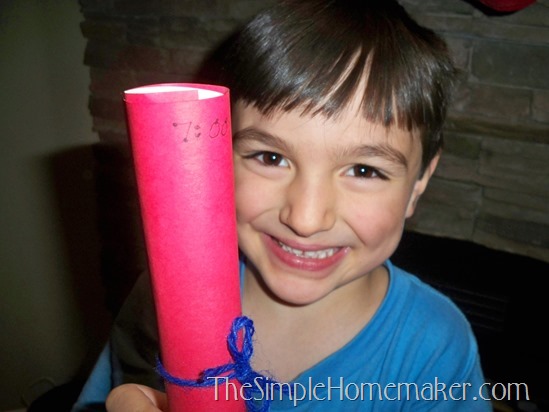This post contains affiliate links. That means that if you purchase something through one of my links, I receive a portion of the proceeds. It costs you nothing, but it helps us buy schoolbooks, because, believe it or not, kids don’t stay preschoolers and kindergartners forever.
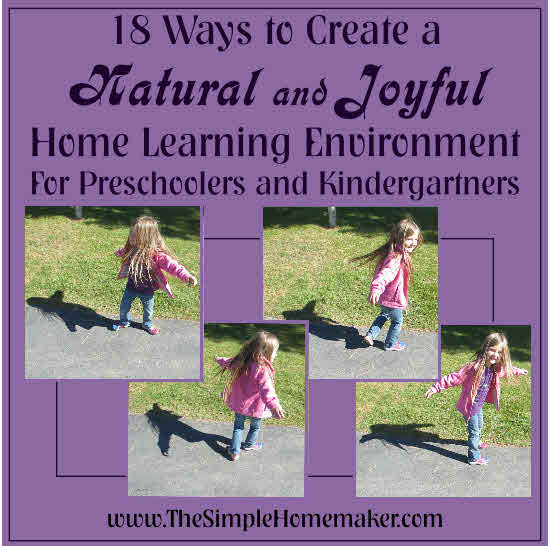
I shared with you my big-mouthed opinion on pushing young children beyond their readiness levels. What you should be asking at this point is “Who are you?! Who are you to be saying this? Do you have a degree in education? Do you have a title?”
Good question. I’m glad you asked.
I do not have a degree in education. For what it’s worth, I have a triple major in English, communication, and communicative arts (whatever that is), but that’s not what qualifies me to write this post..although it does help me properly punctuate this post. What qualifies me is my “experience in the field” of homeschooling little ones–sixteen years of it. For over sixteen years we have been creating a natural, enriching learning environment for our kids, and, yeah, while they’re all a little weird cuz the apple doesn’t fall far from the tree, they all have an unquenchable love of learning.
How do we do it? How do we ensure that our littles are growing in wisdom, knowledge, and a love of learning through their early years? In other words, how do we “do preschool and kindergarten” at home? I’m glad you asked.
18 Tips for Creating a Natural Learning Environment for Preschoolers and Kindergartners
In random order, because random is fun.
1. Read together daily.
I cannot overestimate the value of sitting together and reading. It doesn’t have to be a formal reading session. Some days it can be as simple as saying “yes” when a little one brings a book or reading a favorite bedtime story every night. Some tips:
- Become regulars at the library, but not during flu season if you have a book-licker or a nose-picker.
- Give books as gifts to build up your library within your current budget.
- Follow along with your finger as you read so they see that words have meaning, and they begin recognizing some of them.
- Don’t shy away from chapter books or non-fiction. They don’t bite…except for maybe that pop-up shark book.
- Gradually get rid of the dumbed-down books. Your children are apparently smarter than the people writing the children’s books. Adios, Disney!
- Repeat your child’s favorite books or poems often to teach memorization skills.
- Don’t worry if your child can’t sit through a simple picture book or you can’t get past the first page because of all her questions. This is normal! Don’t make “finishing the book” your goal and lose sight of the needs and abilities of the child on your lap.
- It’s okay to let your reading be the “background noise” as your children play, eat, or take a bath.
- Don’t be afraid to read straight from the Bible with your littles. It was written for them, too.
- For a bit more on this topic, read my post entitled Read Aloud to Your Children. It’s about reading aloud to your children…if you didn’t catch that.
2. Cook and bake together.
Children in the kitchen make a big mess and they slow you down, partly because your feet stick to the floor. Still, if you keep them out of the kitchen, they lose out on an excellent opportunity to learn this:
- cooking skills
- cooperation
- following directions
- safety lessons
- developing a habit of follow-through and clean-up
- strong work ethic
- the joy of caring for and serving others
- preparation for a future in which, chances are, they will need to eat.
- basic math lessons. (When you’ve been doubling, tripling, or halving recipes in the kitchen for years, a worksheet full of fractions is a piece of cake! Mmm, cake.)
Keeping them out of the kitchen robs you of this:
- an element of joy to your work
- bonding time
- over-easy eggs and toast, caramel apple pie, homemade bread, and fresh cookies made by (supervised) six- and seven-year-olds.
Bring it on!
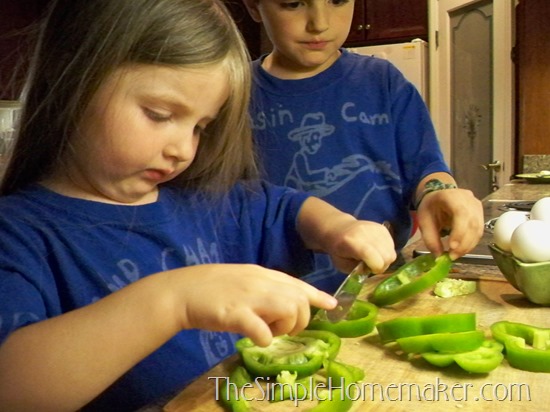
3. Explore nature together.
This can be as simple as planting a pot of flowers and putting up a birdfeeder on an apartment balcony, or as elaborate as visiting national parks and homesteading. Take walks through parks, get good and dirty in a garden, or lie on your stomachs to stare at a square foot of earth. Follow ants, watch butterflies, look closely at flowers, be observant with your five senses. Look up discoveries in field guides if the interest is there, but don’t force it. Keep this fun and informal as you wonder together in awe at God’s creation.
Help your littles begin the practice of keeping a simple nature journal–simple! For now, give them a blank notebook (check craft sections or office supplies) and let them “draw” what they see, draw it for them, take pictures, or press flowers and leaves. We sometimes tape treasures into their nature journal and cram it back into the book shelf to press it. (That is not the right way to do it, but it works for us. I use to use a flower press like this one, but…well…now I don’t. Uh, that’s an affiliate link.) We’ve even been known to smear interesting colored mud and dirt on a page or two.
To perk interest in nature when stuck inside, try classic stories like Beatrix Potter’s tales for the youngest set, Parables of Nature by Mrs. A. Gatty, Thomas Burgess’ Bird Book for Children and Animal Book for Children, Rudyard Kipling’s Just-So Stories, and...somebody stop me! (These are affiliate links, although most of them are free.)
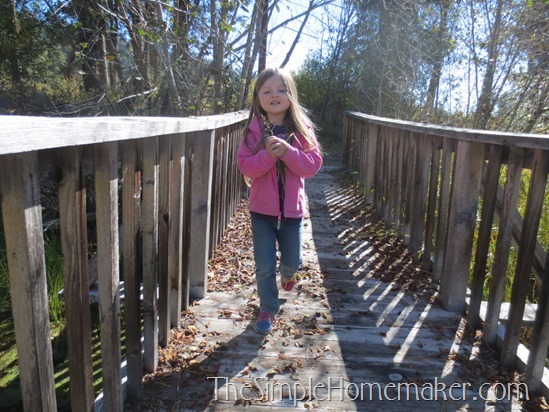
4. Teach your little one to do what you do.
Are you an artist? Teach her to draw or let her explore alongside you as you work. Are you a cook? Get him in the kitchen, even if he’s making stuff up. Are you a grocery list maker? Give her paper and pencil to make her own list. Do you work on the computer? Let him sit on your lap and press “Enter” when you need it, or open a notepad for him to type in. Break the big jobs down into something small that he can do alongside you. This is especially important for parents who may be gone during the day and find themselves busy with projects and “homework” at night.
5. Answer questions.
I don’t know any child who isn’t full of questions, unless life has drained the God-given curiosity from his soul. When your child has a question, take the time to answer it or look it up together or “figger” it out. Say, “Hmm…I don’t know where that ant is going, but let’s follow it and ‘figger’ it out.” “Figgering” together is a great way to develop a curious mind that takes learning to the next step. By the way, “figgering” doesn’t always have to involve a book. Gravity can be figgered out fairly memorably with an egg and a tall ladder or an upstairs window. Yee haa!
6. Use big words.
When my firstborn was a baby she reached out for a knife. I said “Dangerous!” as I pulled her hand away. Someone scolded, “She’s a baby! She doesn’t know what ‘dangerous’ means.” No, kind Someone, but she will never know what “dangerous” or any other word means if she never hears it. Don’t shy away from the big words. Before you know it, your three-year-old will be lisping, “What an unusual piece of artwork!” or “Actually, I prefer white milk, thank you.”
7. Live life together.
Whatever is going on in your life is an opportunity for your child to learn. Are you headed to the dentist? Touch on tooth care and the job of a dentist. Are you counting out money? Let him help. Are you repairing items in the home? Give your little one a safe tool and ask for help. Chances are you’re not going to find a preschool or a curriculum that includes helping Daddy fix a bicycle. Take him with you to the election booths, the grocery store, church, the bank, the library…everywhere! Feed him, give him a nap, tell him your expectations for behavior, wipe the peanut butter off his chin and bring ‘im with you. Yes, this is harder than going alone, but that’s parenting! Another part of parenting is training your child, so if the reason you don’t take him is because he doesn’t behave, make training a priority at home and away.
8. Hold real conversations.
Discuss big ideas with your little ones. This sets the groundwork for an open flow of conversation throughout the years. If you ask for and respectfully listen to your children’s views on a subject, you will encourage the children to begin to think. When I say think, I don’t mean parroting what their friends or the media says. I mean discern, rationalize, come up with fresh ideas…you know, think.
9. Be observant.
Do you see signs and numbers throughout your day? Point them out as early reading lessons. Do you see someone performing a job? Talk about it. Do you see a critter? Discuss its colors, behavior, and habitat. Learning is everywhere if you keep your eyes open.

10. Develop social skills naturally.
Take your littles to the library, to Grandma’s house, to the voting booth, to Bible study, and anywhere else you go. Don’t waste this opportunity by dumping your child in the nursery as soon as you arrive. Let your kiddos hang out with a mix of people from every generation. This is society; being able to function in society is being socialized.
Teach by example, but also by explanation and practice: “Hey, Kiddo, you’re four now, and it’s time to learn to shake hands like a man.” And then show him and practice. When you’re out, introduce him like a man and let him shake hands. It sets the stage for a teen who will look a person in the eye and say, “Nice to meet you,” rather than grunt at you with earbuds permanently encrusted in his ears. Ugh.
11. Be a learner.
I frequently hear,”I don’t know enough to teach my kids everything they need to know.” Wow, that’s a shocker. Hello! Nobody does! That’s why you teach your kids to teach themselves, and you do this first and foremost by setting the example. Exemplify curiosity. Look things up. Ask questions. Wonder out loud. And do this with your child.

12. Play.
Play together. I don’t mean Barbies…unless you want to. Play chess, blocks, hopscotch, 20 questions, I spy, dollhouse, cars.
Also, let your child play alone so she can develop self-motivation and a bit of independence. Fill her life with a small number of excellent toys and puzzles (we love Lauri puzzles—affiliate link). Aim for quality, not quantity. In fact, keep it simple. Keep it simple! A child in a room full of toys will fill a room full of mess. A child with two cars and a pile of blocks will fill his head with big ideas. So will a child with a pile of dirt and a few sticks. Don’t paralyze their imaginations and make cleaning up an overwhelming agony by filling their lives with too much stuff.
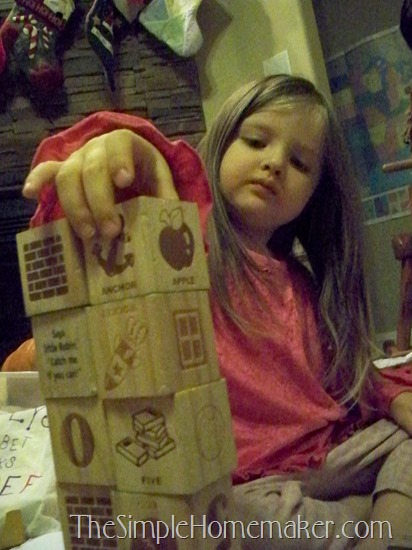
13. Dabble in foreign language.
If you are fluent in a foreign language, use it…all the time. Most of us aren’t so lucky, but that’s no reason to throw in la toalla. Libraries and used curriculum sales generally have foreign language materials. Some pricier companies, like Rosetta Stone, offer samples that are fun for kids. Online apps, games, and lessons are readily available as well. Incorporate the words you learn into your daily life. Your child won’t become fluent in this manner, but he’ll get a great head-start.
14. Explore art and music.
However possible, expose your child to the greats and let him copy them. Get a Bach or Tchaikovsky CD from your library or online and listen while your child colors or plays. (My kids enjoy the Classical Kids collection. Again, sneak it in budget-wise by giving it as gifts for birthdays and Christmas.) Attend local free concerts. Sing patriotic songs, folk music, and hymns with your child, and encourage him to explore a variety of musical instruments that you can pick up at garage sales or as toys, or make your own.
Hunt for books or calendars containing the art of the masters and mention who drew or painted the pictures. Keep a ready stash of art supplies for your children to explore at any time. Replicate the masters, or get a Dover coloring book about an artist of your choice. It doesn’t have to be structured to be effective.
15. Get rid of the desk notion.
Who needs desks and chalkboards and stations? What’s wrong with the floor? Come on, what’s more fun, sitting on a hard chair with pencil in fist, circling the bigger rectangle and the bigger ball on a worksheet, or lying on your stomach on the floor building a house, and then a bigger house out of blocks with Mama? Do a little over and under talk for some spatial recognition training, and you’ve had school, bonding, and playtime. Add cookies and call it lunch.
16. Do a little school.
But didn’t you just say…? Yes, I did. At this young age workbook school is fascinating to some children. Take advantage of that! Here are some items that were well-loved in our home (most of these are affiliate links):
- Kumon books or Big Skills for Little Hands books, such as I Can Cut, although craft time will teach all these skills as well.
- Rod and Staff workbooks–no flashy characters, just black and white drawings and old fashioned fun.
- McGuffey’s Readers (We have reprints of the originals, but they are also available as updated versions (updated does not mean better, just FYI) and free on Kindle or with a free reading app.
- A basic phonics book, such as Phonics Pathways (ours has been through six little learners so far) or Teach Your Child to Read in 100 Easy Lessons.
Keep it short and pressure-free, and stop before their interest fades. Remember, your goal is creating a lifelong learning attitude, not finishing a book or impressing Grandma. Sorry, Grandma!
17. Don’t rush!
There will always be a child smarter, faster, or more talented than yours. That’s just life. (Pick yourself up off the floor.) While life does involve competition, don’t let it pressure you into rushing your little one into things he simply can’t do yet. The only thing your speed will accomplish is burn up your kiddo’s tires like an Indie car. Don’t let the expectations of others or yourself drive you to squelch the precious love of learning innate in children.
18. Don’t worry about the gaps!
If you are afraid your preschool-aged child is missing something vital by not following a pre-planned curriculum or being taught by the professionals, just relax. A young child whose life is rich in experiences, real life learning, and the respect and attention of a loving family will in no way be hindered academically or socially. Yes, your child will miss something. We all have gaps in our learning, including those of us who have been in the system since age two. Instilling in your little one a love of learning, however, will give him the ability and desire to bridge those gaps when necessary, a skill many of today’s adults don’t have. It’s not the job of education to give children all the knowledge they’ll ever need in their lives. It’s the job of education to give children the skills to gain that knowledge for themselves.
How do you create a natural learning environment for your preschoolers and kindergartners?




